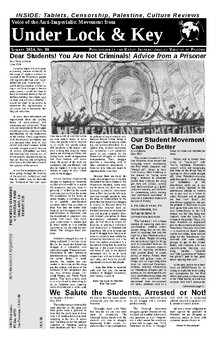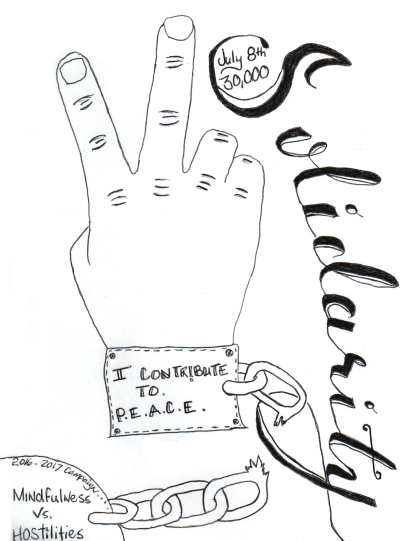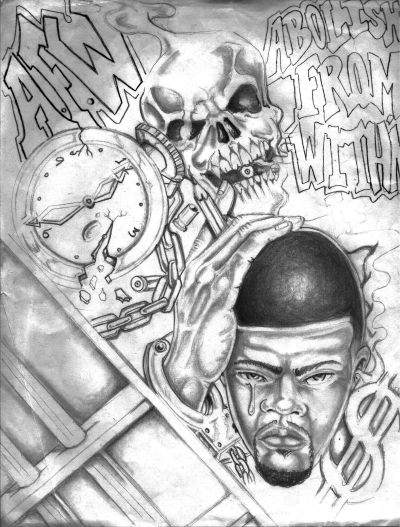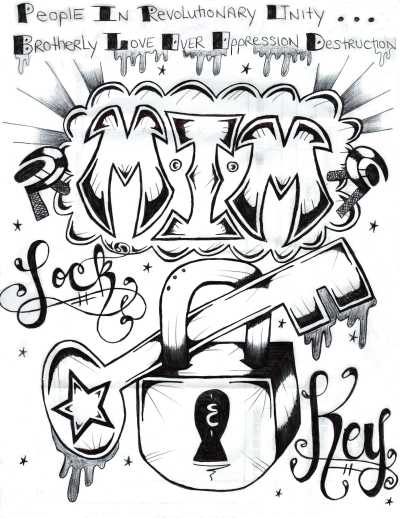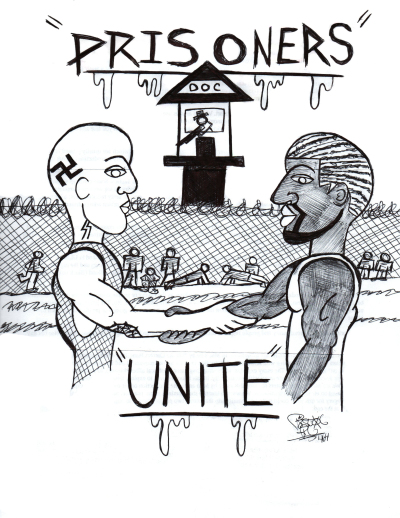Over the past few months the United Struggle from Within - Nevada, has
been hard at work, alongside groups such as the Reetboys and PLF/MISM,
in a show of prisoner unity, building up a grievance campaign. Together,
these groups, with their different ideologies, continue to lead a
struggle for unity and peace within the NDOC.
We have had great success, and we now see open dialogue between and
among groups which had previously been at odds with one another. This
unity is coming in despite of our language, national, religious,
philosophical, and/or ideological differences.
The USW-Nevada, alongside the PLF/MISM, Reetboys, and others, are now
calling on prisoners at High Desert State Prison (HDSP), be you in
general population or protective segregation, to stop the hatred and
join in our current and ongoing struggle against the level system as it
is employed at HDSP. Especially as it relates to the lack of programs,
the inability to earn good time/work time credits, get parole, or be
released. Prisoners housed at HDSP are being denied the very same
opportunities given to every other prisoner at every other prison within
the NDOC.
The grievance campaign has been ongoing, and over the past 2 months we
have seen some 100+ prisoners file grievances on this issue. The
response we have received has shown the attitude of the HDSP
authorities. Namely that education, programs, and work are a privilege,
not a right. This is being said despite the mission statement of
director James Dzurenda, which states the following:
“The Nevada Department of Corrections will improve public safety by
ensuring a safe and humane environment that incorporates proven
rehabilitation initiatives that prepare individuals for successful
reintegration into our communities.
“Vision – reduce victimization and recidivism by providing offenders
with incentive for self-improvement and the tools to effect change.
“Philosophy – we will pursue our mission with integrity, act in a
professional and ethical manner, be responsible for our actions, and
raise the department to the highest standards.
“Goals – operate the department according to the best practices. Ensure
the best use of department resources, educate stakeholders and
customers, improve communication.”
The actions being taken at HDSP, where the overwhelming majority of
prisoners are denied work credits, programs, and any advancement within
the level system itself, are contrary to this mission statement, the
best interest of society overall, and the welfare of the inmates housed
here.
Every day that we allow this to continue is another day that we will be
forced to stay in prison. HDSP is denying us work time credits, which
costs us 5 days a month, as well as education, which costs us 120 days
for a GED, and 120 days for a high school diploma. While every other
prisoner in any other prison within the NDOC earns these days, we at
HDSP must do more of our sentences. For example, if you have a 12-48
month sentence, you will get out in approximately 912 days by working
and getting both your GED and high school diploma. However, at HDSP,
even if you do not receive a single notice of charges, the same prisoner
would be forced to do every single day of that 4 years. Meaning the same
inmate is required to do 548 more days on his sentence for simply being
housed at HDSP. This number increases when you consider the days that
can be earned by completing programs not available to prisoners at HDSP.
Think about this number!
The United Front for Peace in Prisons (UFPP), a movement underway in
Nevada, alongside the United Struggle from Within, the PLF/MISM,
Reetboys, and many national groups have joined together in a single
voice to call for unity, and an end to prisoner-on-prisoner violence,
and to join together in a struggle for change. Join this struggle for
change.
The grievance campaign will continue into a civil complaint. We will
attempt to get it certified as a class action filed on behalf of all
inmates, but in order to do this we need every inmate to file the
grievances, and then file the individual 1983 Civil Complaint. Towards
this goal, we are including examples for each level of the grievance
process, and will make available to all who have completed the grievance
process an example 1983 Civil Complaint.
We have not only completed the grievances, but letters have been sent to
the director and the warden of HDSP. We have also been able to, via a
whistle blower, get our hands on OP516, which describes the level
system, but is marked “no inmate access.” We will make this available as
well.
We will end this here, but before we do we would like to say that in
order for change to occur we must stand up and fight together for that
change. The reason that things have gotten as bad as they have is due to
cowardice. We have become so individualized that we covet what little we
have, and fear retaliation. When is enough enough? Let us build up a
voice and fight, as a single, unified body, for what is just!
Contact USW-Nevada through MIM(Prisons), for more information about
prisoner issues and the continued struggle: MIM(Prisons), PO Box 40799,
San Francisco, CA 94140.
AR740 and the Grievance Process
Nevada has implemented an unconstitutional grievance process. This
grievance process is outlined in AR740. It states that an inmate may
file no more than a single grievance in a single week, and that no more
than a single grievance issue may be raised in a single grievance. This,
of course, is unconstitutional, and should be challenged. But we are
still required by law to adhere to the grievance process, no matter how
unconstitutional it is, if we want to get to court.
We know that many prisoners have trouble with the grievance process. We
will go over the basic process here so that you will know exactly what
to do.
Step one – Start to write kites to your caseworker, unit SCO, and every
job position, requesting placement in work, or to join programs. Save
these responses, and a copy of the original request to show proof.
Step two – Get an informal grievance from your floor officer, be he/she
a porter or a bubble office. Also get at least a grievance continuation
form. Fill out the grievance using the example given herein.
Step three – Fill out your name, cell number, institution, etc. and then
sign and date the grievance. This should be done first so you don’t
forget. The same needs to be done for the grievance continuation form.
Leave the grievance number area blank.
Step four – Using your own words, write your grievance.
Step five – Tear off and keep the last page of the grievance and
grievance continuation forms.
Step six – Put the remaining pages, folded together, in the grievance
box.
Keep track of your days. They have 45 days to answer your informal
grievance. If you have not received a response on day 45, proceed to
your first level grievance.
When filing your first and second level grievances, follow the same
instructions as above, but attach the copies of the grievance, and any
responses you have, with the grievances.
It is important to proceed through all 3 grievance levels. You have 45
days for the informal, 45 days for the first level, and 60 days for the
second level. Make sure you keep a copy of every kite, grievance, etc.,
you have. You want to build up as much evidence as possible, so always
have your unit officer sign your kites, and keep a copy. Every week you
should send out as many kites as possible requesting job placement or
program participation.
Grievance Example
I am grieving the application of the level system as it is employed at
HDSP as it relates to programs, work, and educational opportunities.
This grievance is based on my due process and equal protection rights
based on the future of HDSP to offer me any ability to earn good
time/work time credits which is available to all prisoners within the
NDOC but those housed at HDSP.
Why is HDSP denying me any ability to program when Director Dzurenda has
specified in his mission statement that: “The Nevada Department of
Corrections will improve public safety by ensuring a safe and humane
environment that incorporates proven rehabilitation initiatives that
prepare individuals for successful reintegration into our communities.”
The mission statement then goes on to say the vision is to “reduce
victimization and recidivism by providing offenders with incentive for
self-improvement and the tools to effect change.”
None of this mission statement is being applied at HDSP. In fact the
level system denies prisoners any ability to program, educate ourselves,
work, or any other means by which we may better ourselves, which, as
stated by Director Dzurenda, is the goal of NDOC. Furthermore, not only
are you endangering society by failing to offer rehabilitative programs
to the 3,500 prisoners at HDSP, you are denying me due process and equal
protection.
Every other prisoner, on every other yard, irregardless of level, is
given the opportunity, even encouraged, to participate in programs.
Meaning a prisoner serving a 12-48 month sentence on any yard other than
HDSP, who works and programs, which is available to every prisoner, will
do approximately 912 days of the 1460 days sentenced. The very same
prisoner, housed at HDSP, receiving no writeups his entire sentence,
will be forced to do the entire 1460 days. Meaning, HDSP is making
prisoners do 548 more days on a 12-48 month sentence for no other reason
than he is at HDSP. This is an unconstitutional violation of my right to
due process and equal protection because any other prisoner, with my
exact sentence, will be released earlier than I will, for no other
reason that I, being housed at HDSP, am being denied the same access to
programs available to prisoners on every other yard within the NDOC.
How can the NDOC justify telling prisoners who are begging for
rehabilitative treatment that they do not deserve treatment, that this
is a privilege, not a right? The warden and caseworkers at HDSP are
refusing to help prisoners better themselves and are thus directly
responsible for the recidivism rate, violence and crime that occurs at
HDSP.
Why does HDSP see fit to deny drug addicts or sex offenders treatment?
How will the community react when they find out HDSP is refusing to
treat its prisoners, who are begging for treatment, and then releasing
these people back into their community?
The fact is that HDSP houses approximately 3600 prisoners but work,
education and rehabilitative programs, are available to only
approximately 470 prisoners. That leaves 3130 inmates without any access
to work, education, or rehabilitative programs. Which in turn means that
I, and these 3130 prisoners, are being denied access to the very
programs offered to every other prisoner within the NDOC.
Remedy Sought
-
I want HDSP to offer rehabilitation programs to all 3600 inmates at
HDSP.
-
I want HDSP to review the mission statement of Director Dzurenda, and
act accordingly.
-
I want HDSP to stop punishing me and other prisoners for simply being at
HDSP, and recalculate my days to include the 5 days a month due to the
lack of work/programs at HDSP.
-
I want HDSP to employ active, proven rehabilitation programs as a
means/requirement for advancement within the level system, and not as a
privilege.
For the remaining answers, on levels I and II of the grievance process,
utilize this example, but formulate your response based on their
responses to your grievances. Do not become disheartened by the denials.
They will fight us on this.
Some further ideas for grievances
Others and I are also currently grieving the following issues. All of us
should challenge them. They are, but are not limited to:
-
The lack of proper hygiene supplies. 1 roll of toilet paper and 2 bars
of soap a week is not sufficient. Furthermore, every other prison makes
soap readily available, with 2 rolls of toilet paper.
-
No cleaning supplies, and lack of time to clean cells.
-
Toilet timers. No other prison requires inmates so long between flushes,
especially when locked down in a cell, with another inmate, 22 hours a
day.
-
The grievance process. The new requirement of 1 grievance a week is
unconstitutional and forces us to choose what issues to address. It thus
directly effects our ability to access to the court.
-
Supervisor Graham, and the law library. Supervisor Graham routinely
denies access to the courts by refusing to make legal copies,
confiscating legal work, and has written at least one false notice of
charges.
If you know of, or can think of more issues, please feel free to contact
the USW and let us know.

